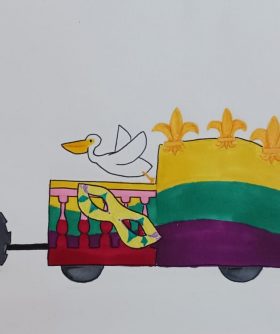By Errol Laborde
Carnival is a fragile season that is often threatened, though I am amazed at how the spirit seems to survive. There are signs that people really do care and really want the season to have class, significance and style. They even have the guts to reject the corporate thumbprints that are now placed on most of life’s other events. In recognition of that spirit, here are four reasons to be thankful for this Carnival season.
4. Marching groups in the Quarter. By mid-afternoon on Mardi Gras, there is a mood shift in the Vieux Carré. By then the crazies and the drunks have passed out, and the male college students with their primal yells mercifully suffer from laryngitis.
From the distance there are the sounds of tambourines, drums and haunting chants. In spots, the Quarter takes on a medieval character as marching groups wind their ways through the neighborhood. The Society of St. Ann (named after the street, not the saint), having begun its trek in the Marigny, works its way to Canal Street to see Rex and then travels back, glistening in costumes worthy of the Venetian Carnival. Another group, the Ducks of Dixieland, pull off a double satire dressed as ducks who are themselves satirically costumed. With each outbreak of music along the way, the Ducks stop to dance. Even among ducks, it’s hard to keep the spirit down.
3. Momus’ spirit survives. When the Knights of Momus stopped parading due to the fallout from the 1991 Carnival ordinance controversy, Carnival lost its one satirical krewe. In an age in which some cheesy new krewes were applying generic themes to whatever floats could be rented from the float builders’ lots, Momus bothered to make a statement, using its floats to poke fun at the events of the day. Momus’ loss was a huge one, but at least the sprite beneath its jester’s cap escaped and now manifests itself in three krewes; Muses, Le Krewe d’Etat and (most of all) the Knights of Chaos, which looks and acts a lot like what Momus was. (The Knights even depart from Momus’ former float den and parade on Momus’ former Thursday night timeslot. In some ways, the krewe’s satires “out-Momus” Momus. Chances seem remote that Momus will ever parade again, but its influence is now thrice as nice.
2. Al Johnson. Here’s one of the good guys of Carnival. In 1959 Johnson first recorded one of carnival’s rhythm and blues classics, “Carnival Time.” The song begins with a staccato horn blast followed by Johnson wailing:
The Green Room is smokin’
And the Plaza’s burnin’ down,
Throw my baby out the window
Let the joints burn down
All because its Carnival time
Everybody’s having’ fun
For a whole bunch of sticky legal reasons, the rights to Johnson’s songs wound up in someone else’s control. Legal battles have been waged through the years. Several years ago, Johnson was finally recognized as having the rights to his song. Because the recording is so old and so regional, he won’t make much money from it, but at least he can say it is his. This year is the song’s 50th anniversary, an event that is even being celebrated with a state lottery scratch-off card. May that bring lots of luck to Al Johnson. He deserves it.
1. Beating back commercialism in New Orleans. Many have tried. Several years ago a company wanted its product recognized as the official wiener of Mardi Gras, and a few beer companies and radio station push it to the edge in a couple of parades, but for the most part New Orleans has taken its stand against commercialism in Carnival parades. Not only is it against the law, but the law is enforced. No thank you Nokia, wrong-number dot-coms, Carnival in New Orleans, if not in some suburbs, remains as an American oddity, a public spectacle that is not sold on the marketplace but paid for by the participants.
Krewe: The Early New Orleans Carnival-Comus to Zulu is available at all area bookstores. Books can also be ordered via e-mail at gdkrewe@aol.com or (504) 895-2266.
Reprinted with permission of the author.



